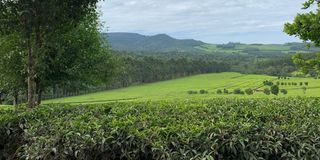The big surprise that is Tendeno Forest in Kericho County

Tinderet forest bordering Tendeno forest from Williomson Tea Estate near Nandi Hills. Photo | Avnish Pandhal
What you need to know:
- It’s a beautiful drive up the mountain that’s almost 7,000 feet high with the lobelias and giant ferns peeking through the forest trees, the undergrowth a rich tapestry of vines and twines
- The rivers running down the slopes like the mighty Nyando keep the great African lake, Victoria, fresh
At the crack of dawn on the last day of 2021, the sun in the eastern sky bursts like a furnace of red-orange flames to begin its daily swoop over the earth. In the midst of it, we’re driving through the sugar-cane fields on the plains of Chemelil at the foothills of the magnificent Nandi Hills in western Kenya.
The plan for the day is to enjoy the cool mountain air on Tinderet, a volcanic massif across the road from the Nandi stretch of hills, famous for its flashes of lightening from which it derives its name Tinderet – and the once upon-a-time elephant. The last bull elephant survived until the new millennium.
Tinderet looms with its highest peak pointing to the sky as we turn in at Songhor with more sugar-cane plantations and a prehistoric site that dates some 15 million years ago with fossils that lay buried courtesy of Tinderet’s volcano when it erupted. The cane gives way to cleared patches of the once forested hills and tea – lush green climbing up the mountain, neatly laid out.
It’s the Williamson tea estate that started planting tea on Tinderet in 1956 on a eucalyptus farm. The new tea bushes were planted with a seed flown in from Kiganga in Tanzania. In 1961 when the first leaf was processed in the new factory, Tinderet won many awards at the Eldoret Agricultural Show courtesy of the perfect soil and the essential rain provided by Tinderet’s indigenous forest.
The road turns into murrum and the higher we climb, the cooler and fresh the air becomes. The indigenous forest lining the tea plantations is a thick, impenetrable cover – like giant heads of broccoli.
And then like magic, as if turning a new page in a novel, the road runs through an alpine zone of giant lobelias, their long stems drooping with the weight of the flowers – in botanical terms called the inflorescence. We’ve reached the moorland! These long-stemmed forest plants need sunbirds to pollinate them, so we are assured of seeing the pretty nectar-sucking birds.
It’s a beautiful drive up the mountain that’s almost 7,000 feet high with the lobelias and giant ferns peeking through the forest trees, the undergrowth a rich tapestry of vines and twines. The rivers running down the slopes like the mighty Nyando keep the great African lake, Victoria, fresh.
Suddenly there’s a clearing in the forest of carpeted grass like out of the movies. The highest point of Tinderet looms in the distant.
A herder leads his cows down the red earth road and we reach the edge of the forest with a potato field in flowers of lilac and neighbouring it, the forester’s office that has no sign.
The foresters allow us to enjoy a picnic breakfast in the natural glade open to the skies. The air is heady as we breathe in large doses of pure oxygen, filling our lungs to capacity –an escape from the masked-days of the Covid pandemic.
A turaco moves through the branches of a cedar tree. The colobus monkeys screech out as the sun begins to warm the forest. The breakfast of hot coffee and toast tantalizes the buds.
The forester, Erick Rotich shows us around the nursery of indigenous trees of podos and cedar, native to the forest.
The forest man tells us we are in Tendeno forest and not Tinderet forest, which borders it.
“Tinderet forest falls under Nandi County while Tendeno forest falls under Kericho County,” explains Gibson Kitsao of Nature Kenya, the natural history society formed in 1909 and open to membership.
“In the old days, the local people relied on the lightning from the forests to determine their seasons.”
There are no hiking trails or guides to guide us through the ancient forest. However, with prior arrangement this can be arranged tells the forester.
Tendeno is rich in history. It is one of the forest homes of the Ogiek people, whose name means ‘caretaker of all plants and wild animals’. They are one of Kenya’s last remaining hunter-gather communities, living in the forests of the Mau, Elgon and Tinderet. As specialized honey gatherers, it was in their interest to keep the forests alive. However, the community has been repeatedly evicted from the forests but a landmark ruling on 26 May 2017 (after an eight-year court battle) by the African Court on Human and Peoples’ Rights based in Arusha, Tanzania, ruled in the community’s favour. But nothing has come of it since.
A slow drive down the forest slope reveals indigenous trees being felled along the road for it to be tarmacked to Kericho.
Travel Tinderet
Tendeno forest is 700 hectares while Tinderet is 7000 hectares.
This fascinating volcano is accessible via the Chemelil-Nandi road. Other sites of interest are the Nandi Bears Club for golfers, exploring the many sites on the long stretch of Nandi Hills for hiking, birding and cultural tours like the museum dedicated to the Nandi leader Koitalel Arap Samoei killed by a colonial administrator, the prehistoric site at nearby Fort Ternan and the longest bridge in East Africa and so much more. For accommodation, try Nandi Bears club, Kweisos House or do a day trip from Kisumu, Kericho or Eldoret.
Call Warden Rotich on 0729 416499 for a hike in Tendeno forest.
www.rupitheafricantrotter.com
For feedback to the editor email [email protected]




